Circle of Fifths
Home: Jazz Chords for Baritone Ukulele
The Circle of Fifths is exactly the sequence of notes discovered by Pythagoras, and can be reconstructed using our modern scale by continuously going up a fifth from a starting note. Here are those notes, each a fifth higher than the previous one. (Each sharped note has a corresponding flatted note not shown.)
C G D A E B F# C# G# D# A# F C
Those can be used as notes in a song, or chords in a progression, or changing keys. In each case the Circle of Fifths provides the harmonic structure discovered by Pythagoras.
Fly Me to the Moon
Many jazz songs use parts of the Circle of Fifths, but Fly Me to the Moon is famous for its chord changes that walk the full circle. Well almost.
- It’s a simpler circle, and
- a different scale, and
- backwards.
A Simpler Circle
Because we’re playing chords whose notes want to stay in the main scale, we’re not really interested in the chromatic sharps and flats. We can skip them by using the 1 and 5 of the chords to define the fifths, rather than strict, 7 half step, perfect fifths.
For example, in the key of C the first chord is CMaj7.
C E G B
The 5 in that chord is G, so G is the next chord. Now for this case, the interval from C to G is a perfect 5th, so it makes no difference.
And it’s the same for almost all of the other chords, which start with either a major-minor third pair or minor-major third pair. That is, chords with a perfect fifth between the (1) and 5.
But the seventh chord in the chord scale is different. It’s half diminished, meaning it starts with a minor-minor third pair. In C it’s the Bm7(b5).
B D F A
It indicates the next chord will be F! Not F#. Yay! (The interval from B to F is one fret shy of a perfect fifth neatly creating a short cut over all the sharped/flatted notes.)
This is called the diatonic Circle of Fifths, meaning, for the key of C, that all the notes used are notes in the key of C. Here are the notes in the diatonic Circle of Fifths for the key of C.
C G D A E B F C
A Different Scale
We’ve just talked about major scales in this book because the notes of the major scale are used to define chords. A minor chord, for example, is defined as 1 b3 5, still referring to the major scale.
But now that we’re talking about songs in keys, major and minor matter. The chords for Fly Me to the Moon start with A minor. It is the minor key associated with C, so it uses all of the same notes, just starting at a different place.
We can use it to build the minor Circle of Fifths, starting at Am7. The B – F transition again saves us from the #s and bs.
A E B F C G D A
Backwards
Fourths are the same as fifths but going in the other direction. Up a fifth is the same as down a fourth. The Circle of Fifths, drawn as a circle, has the chords going clockwise, but if you go around counter clockwise, the intervals are all fourths.
Here is the Circle of Fourths for A minor.
A D G C F B E A
The Chords
We can now associate that circle with the chord scale.
Am7 Dm7 G7 CMaj7 FMaj7 Bm7(b5) Em7 Am7
These are the chords of Fly Me to the Moon. The Circle of Fifths, abbreviated, in a minor key, backwards. Beautiful.
Fly Me to the Moon, verse
Fly Me to the Moon is made up of verses and choruses. It is the verse that uses the full Circle of Fourths. Here are the chords indicated in 3/4 time, although it is often played in 4/4 time as well. There is one small change, an E7 is used instead of Em7, which, we’ll see, is just fine.
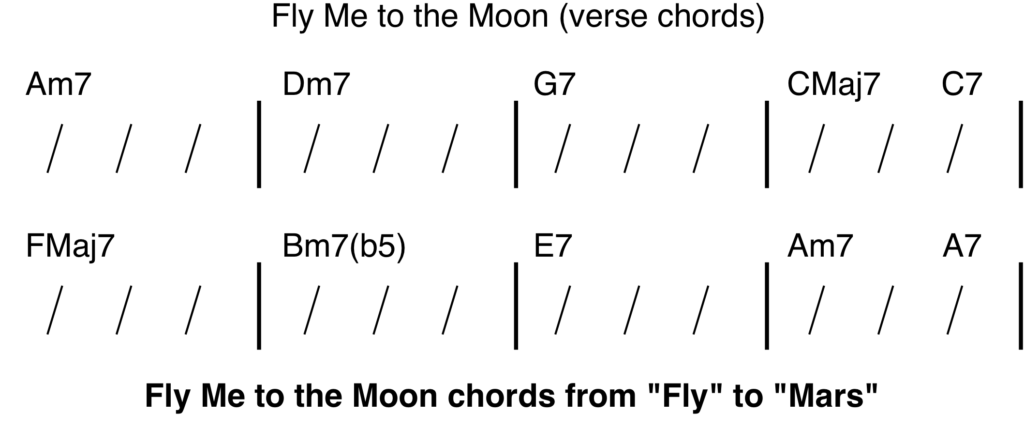
There are numerous choices for playing these chords, but it’s fun to pick shapes that allow them to be played cascading down the fretboard along with the melody.
The first step then is to find the places on the fretboard where the roots of the chords will be.
Here is a nice sequence starting at the A on the seventh fret and alternating between the fourth and third string finding the notes on the way back to the nut.
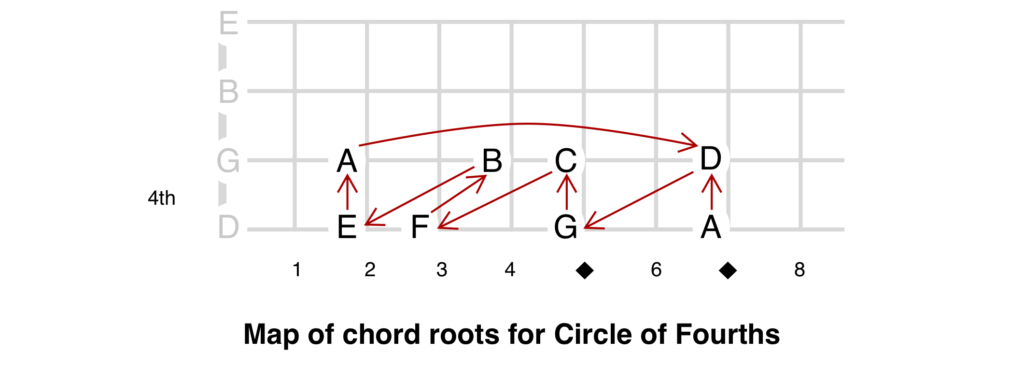
Using the shapes for the different flavors of chords, Xm7, XMaj7, etc. here are the shapes that, with the (1) over each of the notes above, bring that route of roots to life.
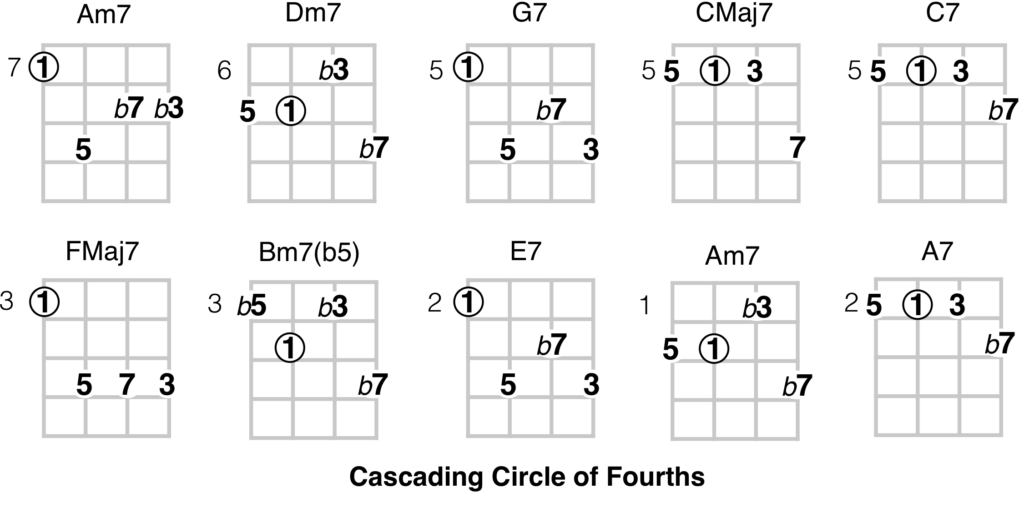
It’s pretty, isn’t it? And flows really well with the melody.
The Melody
I can’t include the melody here (see the section on copyrights at the end of the book), but, if you don’t know it, it can be found for personal use from sources on the Internet.
There is a really cool thing that can be discovered about the melody in the chords chosen. The melody notes that start each measure are included in the shapes. They are always the 3 or b3 of the chord.
Here are the notes in each chord, and the starting note of each measure in the verse.
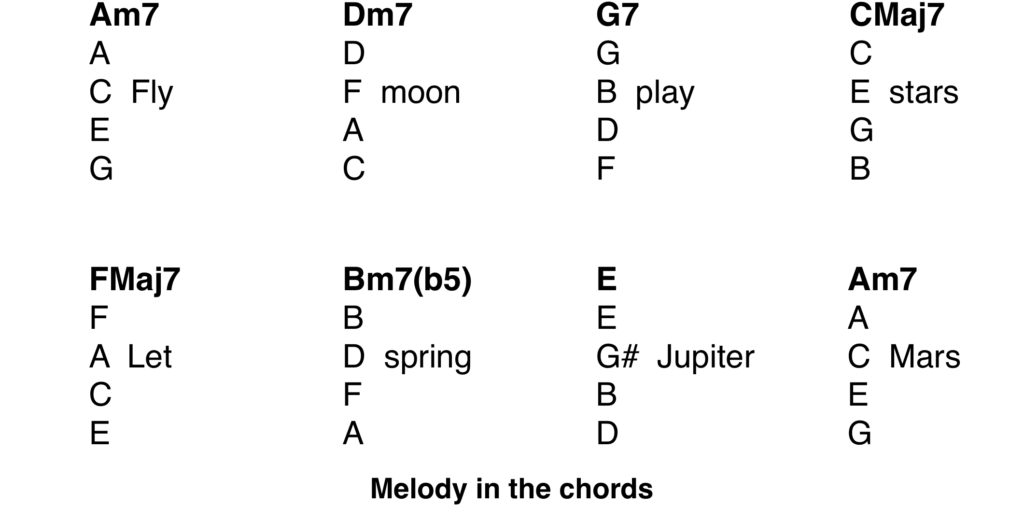
Our cascading chord progression lines up perfectly with the melody, as its notes also cascade down in perfect harmony with the chords.
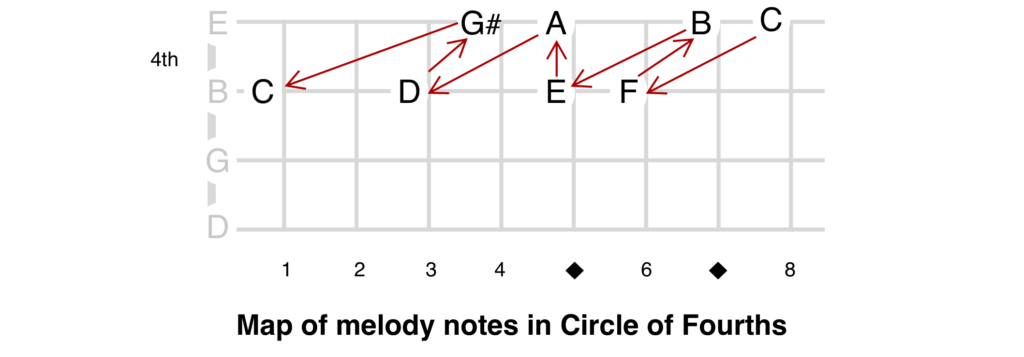
We generated the chord progression by moving the root back and forth between the third and fourth strings. That means the chords alternate between a 1 5 7 3 inversion and a 5 1 3 7 inversion.
Stacking them we see the roots and melody move in perfect harmony.
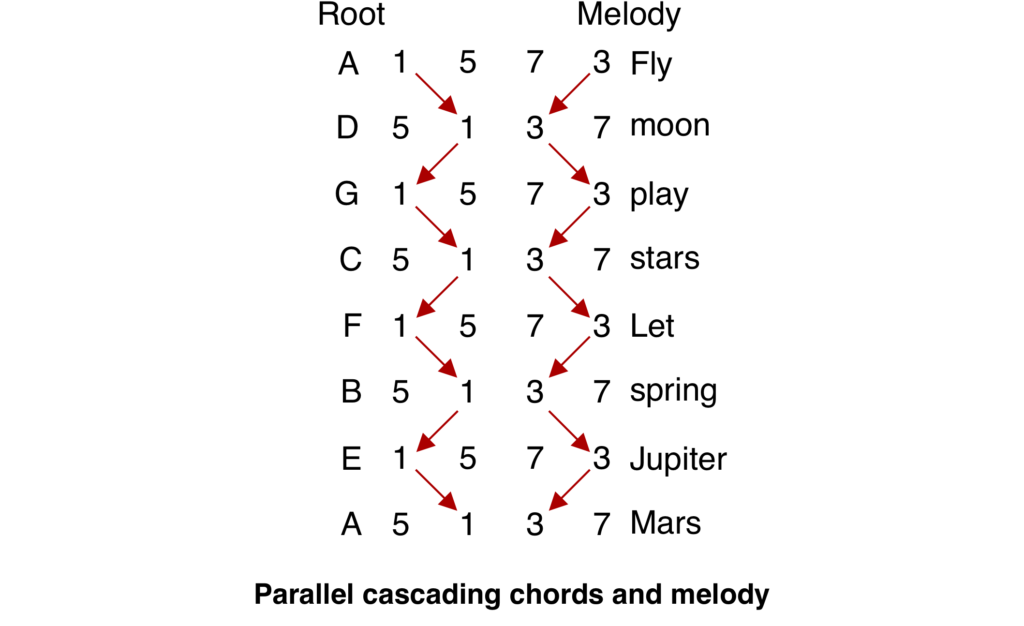
Having said all that, when it comes to actually playing the progression, I find the first Am7 on the seventh fret a bit awkward and really enjoy starting with the Am (or Am7) at the nut instead. It can be dramatically slid up to the Dm7 on the sixth fret (it’s the same basic shape), and from there the shapes cascade back to that same chord.

In Other Words, Chorus
This was the original title of the song and is the basis of the chorus. It has interesting and fun chords but leaves the full Circle of Fourths behind.
There are a number of arrangements of chords that can be used for the chorus. Some continue in the vein above with nice jazz chords played around the middle of the fretboard.
The ones chosen here are a bit different. They make use of open chords around the neck and are easy and fun to play. They might be ones that work well with Frank Sinatra’s version of the song.
There are three versions of the chorus, one with the main verse, one in an instrumental break, and one ending the song.


The instrumental solo has a different set of chords for “Other Words” that is fun to take up to the high Em and back.
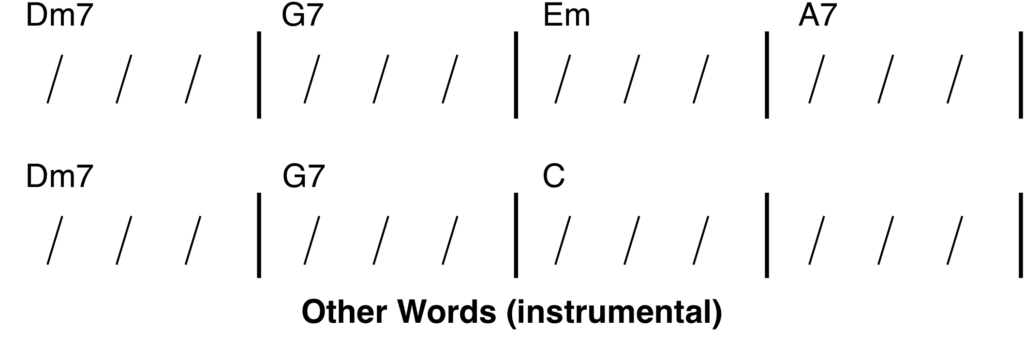
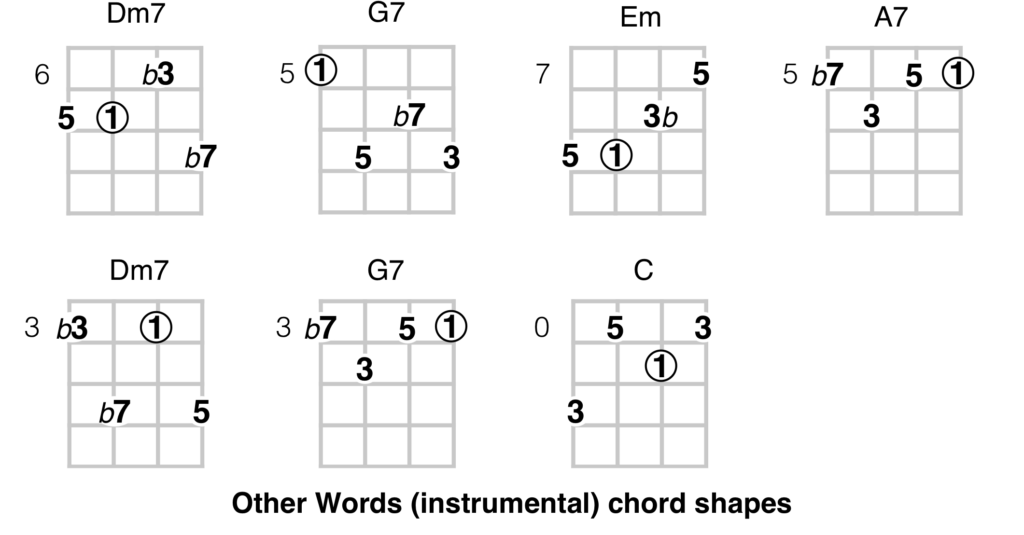
The second verse is then repeated and there’s a final flurry to finish “I love you” on a high C note.
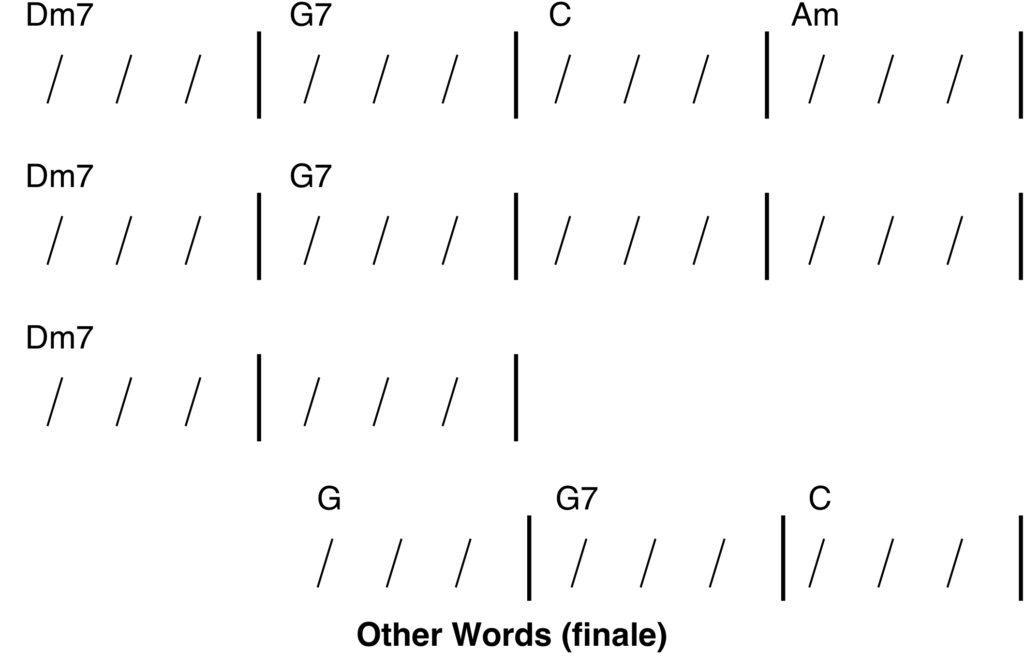

The Point
The point of all this being, armed with a knowledge of how to select chords, one can create instrumental arrangements that fit their own musical sense and digital dexterity. You find the chords that are both fun to play and fun to hear.

